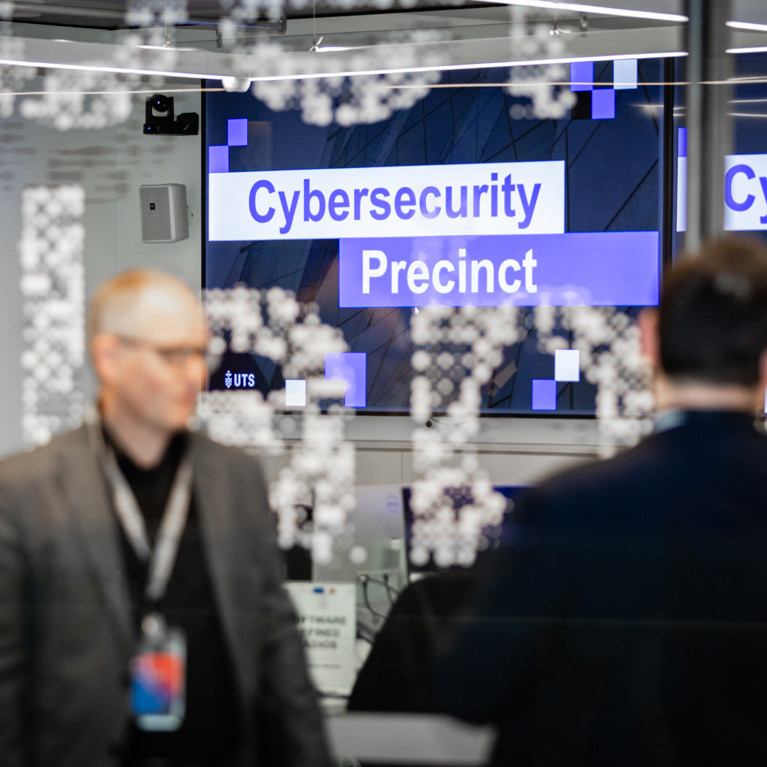- Posted on 18 Jun 2025
- 3 minutes read
If cybercrime was a country, it would be the third largest economy by GDP. And while cybercrime sweeps the world with apparent impunity, about 80% of incidents can be prevented by basic controls.
These striking revelations were among the key takeaways from a lively panel discussion at UTS’s cyber precinct launch on Thursday 12 June.
The panel to discuss the immediate global and national cyber security threat comprised of leading experts in Australian cybertechnology:
- Lieutenant General Michelle McGuinness, National Cyber Security Coordinator, National Office of Cyber Security
- Katie Payten, Chief Digital Security Officer, Challenger Group
- Chris Mohan, Threat Research and Intelligence Principal, Cyber Security, Telstra
- Gayan Benedict, MIT CISR Industry Research Fellow
- Rachael Falk, Partner, Cyber & Technology, Ashurst Risk Advisory.
Members of government, industry, and UTS staff and students joined the panel to tease out the thorny issues surrounding the potential dangers of cybertechnology or vulnerabilitiesof living in the digital world if it is not understood and managed carefully. They canvassed opportunities for collaboration between academia and the private sector, as well as what – and who – should be involved in building a strong and resilient cybersecurity ecosystem in Australia.
Embedding a culture throughout Australian life was a step towards addressing these challenges, said McGuiness. “We need to develop a cybersecurity culture … we don’t have it here yet. We have a physical culture (e.g. ‘slip, slop slap’ for sun protection); this needs to transcend to a digital safety culture and it needs to start from the ground up,” she said.
“We need to develop a cybersecurity culture … this needs to transcend to a digital safety culture and it needs to start from the ground up.”
Achieving this relies on a combination of research, education and application. Falk spoke of the value of collaboration between the organisations that develop, monitor and govern cybertechnology: “We need more sovereign capability, with more research and more commercialisation. Any research is good research whether it succeeds or not.”
UTS has steadily grown its contribution to research, teaching and industry collaboration in the rapidly changing field. It has been recognised as being second in Australia for Computer Science, AI, and Data Science, and in the top five nationally for graduate employability, ensuring a pipeline of skilled cybersecurity professionals.
The new precinct at the university’s Broadway campus in the city is dedicated to cybersecurity education, research and innovation. This recent upgrade establishes a centralised, specialised environment for cybersecurity training, experimentation and innovation, designed to prepare students for careers in the field. The purpose-built facility supports immersive, real-time simulation of cyberattack scenarios; secure, collaborative environments for co-design with government and industry; and workforce development programs tailored to emerging national capability gaps. It will play a pivotal role in driving the economic growth and infrastructure development of Tech Central.

The question of how industry and universities can work together more effectively to address current and future cybersecurity challenges was widely discussed by the panel.
Payton highlighted the importance of making cybersecurity solutions economically viable for small business, saying that “we need to do more to entice diverse cohorts into the industry”, while McGuiness spoke of the importance of creating more industry-ready students: “giving them time in the field is critical with innovative hands on learning and internships and defining pathways for school leavers”, she said.
There is projected demand in Australia for an additional 85,000 cybersecurity professionals by 2030, a 66% increase from 2023. Dean of the Faculty of Engineering and IT Peta Wyeth spoke of the value of collaboration across sectors, saying that boosting capability in a dedicated precinct was “about more than infrastructure. It’s about addressing a national workforce challenge. Meeting that demand will require strong partnerships, bold thinking, and a steady pipeline of skilled professionals.
“Cybersecurity is a space where no single sector can work in isolation. Building capability, growing a skilled workforce, and staying ahead of emerging threats requires collaboration – across education, industry, government, and research.”


